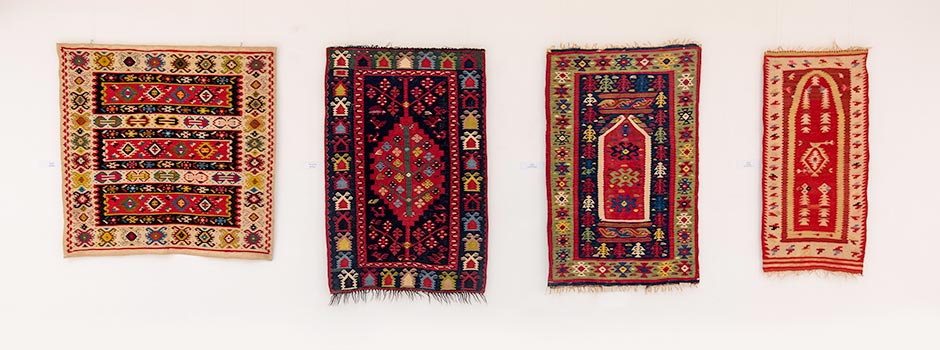
ART COLLECTION Bosnian Kilims from the Collection of the National Museum of BiH
Apr 14, 2018 FEATURE, Art Collection

Exhibited Bosnian kilims are part of the wider collection of oriental carpets from the Balkans, whose production for hundreds of years has been under the influence of Anatolian and Iranian traditions. In addition to the Bosnian, the Sarkoy kilims from Serbia and Bulgaria are also known in the Balkans. The National Museum in Sarajevo has a huge collection of old Bosnian rugs that they collected over the last 150 years.
The kilims cover the time range from the middle of the 19th century until the 70s of the 20th century, mostly dating from the end of the 19th to the beginning of the 20th century.
The Bosnian kilim has all the features of the oriental smooth silk kilim with two sides, unlike Iranian knitted carpets with one side. However, despite the foreign influence, the Bosnian kilim has also developed its originality over time, especially in terms of the use of stylized symbols and compositional patterns, as well as the use of a colour palette that in the 19th century was very moderate and pastel, while at the beginning of the 20th century obtained on its colour intensity, especially due to the use of aniline colours.
The largest carpet centres in Bosnia were: Bosanski Petrovac, Prozor, Bjelaj, Ostrozac, Glamoc, Foca, Rogatica, Gacko, and Stolac. At the exhibition, we can see kilims of different formats and various purposes, from the prayer kilims to the 'makate' kilims with elongated formats, which served as rugs for sitting. What fascinates us in this show is the large number of different approaches to design and size, as well as an unpredictable number of colour combinations. All these carpets were made in women's home workshops, and for some kilims, the name of the author has been preserved.
The exhibition 'Bosnian Kilims from the Collection of the National Museum of BiH' certainly demonstrates to what extent the production of rugs within the smaller environments has been developed and varied, but also proof that it has been preserved in the years of industrialization and mass production development.
The author of the exhibition is the curator Marica Popic-Filipovic, while the exhibition was set up by the conservators Azra Becirevic-Sarenkapa and Damir Lazzari.
-IslamicArtsMagazine.jpg) Bosnian Kilim, Foca, 1880 / Photo © Islamic Arts Magazine
Bosnian Kilim, Foca, 1880 / Photo © Islamic Arts Magazine
-IslamicArtsMagazine.jpg) Bosnian Kilim, Ostrozac, Bihac, 1908. / Photo © Islamic Arts Magazine
Bosnian Kilim, Ostrozac, Bihac, 1908. / Photo © Islamic Arts Magazine
-IslamicArtsMagazine.jpg) Bosnian Kilim, Kiseljak, Sarajevo, 1890 / Photo © Islamic Arts Magazine
Bosnian Kilim, Kiseljak, Sarajevo, 1890 / Photo © Islamic Arts Magazine
-IslamicArtsMagazine.jpg) Bosnian Kilim, Prozor, mid 19th century / Photo © Islamic Arts Magazine
Bosnian Kilim, Prozor, mid 19th century / Photo © Islamic Arts Magazine
-islamicArtsMagazine.jpg) Bosnian Kilim, Sarajevo, 1926 / Photo © Islamic Arts Magazine
Bosnian Kilim, Sarajevo, 1926 / Photo © Islamic Arts Magazine
-IslamicArtsMagazine.jpg) Bosnian Prayer kilim, Prozor, beginning of the 20th century / Photo © Islamic Arts Magazine
Bosnian Prayer kilim, Prozor, beginning of the 20th century / Photo © Islamic Arts Magazine
_IslamicArtsMagazine_01.jpg) Bosnian Kilims from the Collection of the National Museum of BiH, Installation view / Photo © Islamic Arts Magazine
Bosnian Kilims from the Collection of the National Museum of BiH, Installation view / Photo © Islamic Arts Magazine
_IslamicArtsMagazine_02.jpg) Bosnian Kilims from the Collection of the National Museum of BiH, Installation view / Photo © Islamic Arts Magazine
Bosnian Kilims from the Collection of the National Museum of BiH, Installation view / Photo © Islamic Arts Magazine
_IslamicArtsMagazine_03.jpg) Bosnian Kilims from the Collection of the National Museum of BiH, Installation view / Photo © Islamic Arts Magazine
Bosnian Kilims from the Collection of the National Museum of BiH, Installation view / Photo © Islamic Arts Magazine
_IslamicArtsMagazine_04.jpg) Bosnian Kilims from the Collection of the National Museum of BiH, Installation view / Photo © Islamic Arts Magazine
Bosnian Kilims from the Collection of the National Museum of BiH, Installation view / Photo © Islamic Arts Magazine
_IslamicArtsMagazine_05.jpg) Bosnian Kilims from the Collection of the National Museum of BiH, Installation view / Photo © Islamic Arts Magazine
Bosnian Kilims from the Collection of the National Museum of BiH, Installation view / Photo © Islamic Arts Magazine
_IslamicArtsMagazine_06.jpg) Bosnian Kilims from the Collection of the National Museum of BiH, Installation view / Photo © Islamic Arts Magazine
Bosnian Kilims from the Collection of the National Museum of BiH, Installation view / Photo © Islamic Arts Magazine
'Bosnian Kilims from the Collection of the National Museum of BiH' is on view until April 19, 2018.
Comments
Add a comment